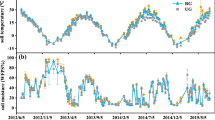The use of standardised plant species as biomonitors of air pollution has been a recognised technique for a number of years (De Temmerman et al. 2004). Grass species have been used extensively in a number of biomonitoring studies (Sant' Anna et al. 2004). These standardised grasses can be used as passive biomonitors, but are more effectively used as active bioaccumulators of a range of gaseous and particulate pollutants (Scholl 1971). The advantage of these standardised plants as bioaccumulators is their ability to accumulate a variety of inorganic and organic air pollutants without showing symptoms of visible injury. Standardised plants can also provide an indication of air pollution impacts over a short time period and are independent of the habitat substrate. Although the use of standardised biomonitors is extensively reported in the literature for the bioaccumulation of sulphurous compounds, heavy metals and trace elements (Klumpp et al. 2004) they have not been widely used as active bioaccumulators of N pollution.
Sommer (1988) exposed barley (Hordeum vulgare var. Harry) plants as a bioindicator of ammonia (NH3) deposition along a 0–300 m transect from a dairy farm for 1 month. The tissue N content of the barley plants was increased closer to the farm reflecting the increased N deposition from ammonia. In a subsequent study, Sommer and Jensen (1991) exposed Lolium multiflorum Lam. along 0–130 m transects away from a dairy farm. Tissue N concentration was found to increase closer to the farm. Dry matter was also increased in close proximity to the farm but did not decrease significantly with distance from the farm. Hicks et al. (2000) used two graminiod species Deschampsia flexuosa (L.) and Nardus stricta L. as potential biomonitors of wet N deposition in upland areas.
Access this chapter
Tax calculation will be finalised at checkout
Purchases are for personal use only
Preview
Unable to display preview. Download preview PDF.
Similar content being viewed by others
References
Cape J.N., van der Eerden L.J., Sheppard L.J., Leith I.D. and Sutton M.A. (2009) Reassessment of critical levels for atmospheric ammonia. In: Sutton M.A., Reis S., Baker S.M.H.: Atmospheric Ammonia—Detecting emission changes and environmental impacts, 15–40, Springer publishers
De Temmerman L., Bell J.N.B., Garrec J.P., Klumpp A., Krause G.H.M., Tonneijk A.E.G. (2004) Biomonitoring of air pollutants with plants-considerations for the future. In: A. Klumpp, W. Ansel and G. Klumpp (eds.) Urban air pollution, bioindication and environmental awareness, 337–375. Goettingen: Cuvillier Verlag.
EuroBionet (2003) www.uni-hohenheim.de/eurobionet
Hicks W.K, Leith I.D., Woodin S.J., Fowler D. (2000) Can the foliar concentration of upland vegetation be used for predicting atmospheric nitrogen deposition? Evidence from field surveys. Environmental Pollution 107, 367–376.
Klumpp A., Klumpp G., Ansel W. (2004) Urban air quality in Europe- results of three years of standardised biomonitoring studies. In: A. Klumpp, W. Ansel and G. Klumpp (eds.) Urban air pollution, bioindication and environmental awareness, 337–375. Goettingen: Cuvillier Verlag.
Leith I.D., van Dijk N, Pitcairn C.E.R., Wolseley P.A., Whitfield C.P., Sutton M.A. (2005) Biomonitoring methods for assessing the impacts of nitrogen pollution: refinement and testing. JNCC Report 386, Peterborough.
Loubet B., Sutton M.A. (1999) Edinburgh protocol for measuring bulk NH4+ of grass leaves in GRAMINAE. In: M. Sutton and C. Milford (eds.) integrating measurements protocol. Centre for Ecology and Hydrology, Edinburgh, UK.
Loubet B., Milford C., Hill P.W., Tang Y.S., Cellier P., Sutton M. A. (2002) Seasonal variability of apoplastic NH4 +and pH in an intensively managed grassland. Plant and Soil 238, 97–110.
Preston C.D., Pearman D.A., Dines T.D. (2002) New atlas of the British & Irish flora. Oxford University Press, Oxford.
Sant' Anna S.M.R., Rinaldi M.C.P., Domingos M. (2004) Biomonitoring of air pollution in Sao Paulo city (Brasil) withLolium multiflorumssp.Italicum“Lena”. In: A. Klumpp, W. Ansel and G. Klumpp (eds.) Urban air pollution, bioindication and environmental awareness, 303–308, Goettingen, Cuvillier Verlag.
Scholl G. (1971) Die Immissionsrate von Fluor als Maβstab für eine Immissionbegrenzung. VDI-Berichte 164, 39–45.
Sommer S.G. (1988) A simple biomonitor for measuring ammonia deposition in rural areas. Biology and Fertility of Soils 6, 61–64.
Sommer S.G., Jenson E.S. (1991) Foliar absorption of atmospheric ammonia by ryegrass in the field. Journal of Environmental Quality 20, 153–156.
Sutton M.A., Pitcairn C.E.R., Leith I.D., Sheppard L.J., van Dijk N., Tang Y.S., Skiba U., Smart S., Mitchell R., Wolseley P., James P., Purvis W., Fowler D. (2004) Bioindicator and biomonitoring methods for assessing the effects of atmospheric nitrogen on statutory nature conservation sites. In: M.A. Sutton, C.E.R. Pitcairn and C.P. Whitfield (eds.) JNCC Report No. 356, Peterborough.
Tang Y.S., Cape J.N., Sutton M.A. (2001) Development and types of passive samplers for monitoring atmospheric NO2and NH3concentrations. TheScientificWorld 1, 513–519.
Author information
Authors and Affiliations
Editor information
Editors and Affiliations
Rights and permissions
Copyright information
© 2009 Springer Science + Business Media B.V.
About this chapter
Cite this chapter
Leith, I.D., van Dijk, N., Pitcairn, C.E.R., Sheppard, L.J., Sutton, M.A. (2009). Standardised Grasses as Biomonitors of Ammonia Pollution Around Agricultural Point Sources. In: Sutton, M.A., Reis, S., Baker, S.M. (eds) Atmospheric Ammonia. Springer, Dordrecht. https://doi.org/10.1007/978-1-4020-9121-6_16
Download citation
DOI: https://doi.org/10.1007/978-1-4020-9121-6_16
Publisher Name: Springer, Dordrecht
Print ISBN: 978-1-4020-9120-9
Online ISBN: 978-1-4020-9121-6
eBook Packages: Earth and Environmental ScienceEarth and Environmental Science (R0)




